
Admin News
You have probably noticed now that each week, we are showcasing examples of remote learning in the Newsflash from various subjects at both the elementary and middle/high school levels. We hope you are finding this informative and interesting! Our purpose for doing this is to give our community an idea of how learning is occurring at various levels in different subjects, and to promote the feeling of community through connectedness as we all work towards our school’s guiding statements.
Another way parents have the opportunity to learn more about how we do things at CIS is to attend our CIS PTA virtual Coffee Morning Meetings! Last week, we covered the question, “How can parents support their children during remote learning?” I have included the main areas covered below for those who could not make it.
How can parents support their children during remote learning?
1. Lay the foundations
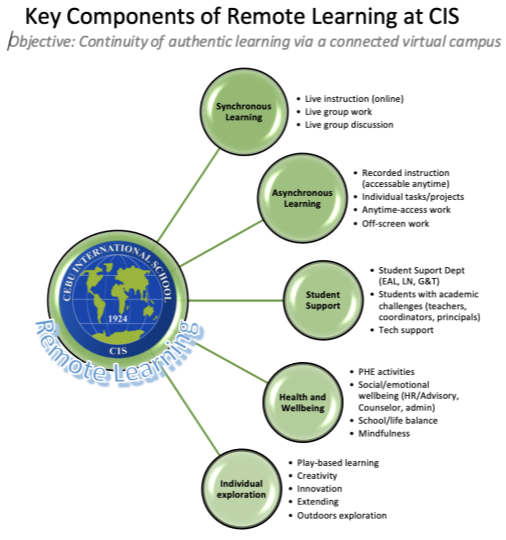
- Are YOU ready to support your child’s academic, social, and emotional learning?
- Children will pick up (and mimic) your feelings/attitudes!
- Be positive/proactive/place importance on learning
- Ask for help (from teachers, keep in touch with other [positive] parents)
- Consider the context (Remote Learning) at home – adapt!
- Consider “Maslow” before “Bloom” (essentially meaning consider health and wellbeing needs before trying to learn).
- Note the key components of remote learning at CIS (refer to the diagram to the right) also highlights the need for a holistic program that addresses five main focus areas that cover both the social-emotional learning as well as academic learning.
2. Prepare a safe space
Physically – uncluttered, resourced, quiet/limit distractions, comfortable,
Emotionally – safe and supportive, protected from stress/fear/harm
3. Facilitate a supportive learning environment
- Provide positive conditions at home (download PDF with details)
- Ensure they take breaks
- Allow them to FAIL (“First Attempt At Learning”)
- Consider their Social & Emotional Learning (SEL) needs
- Relationships with their peers
- What motivates them?
4. Promote optimal learning habits
- Learning should be fun (even if it is hard at times)
- Encourage a growth mindset
- Approaches to Learning skills
- Maintain a disciplined structure to facilitate productive habits (age-appropriate/important for all ages)
- Balance screen time with breaks and non-device work
- Consider your child’s individual needs (personality, temperament…)
A selection of resources with more detail:
- Building Positive Conditions for Learning at Home: Strategies and Resources for Families and Caregivers
- How Parents Can Help Their Kids While Managing Distance Learning
- Keep Calm, Learning is On! Tips and Resources for Parents to Support Learning at Home
- 22 Remote Learning Tips For Parents Helping At Home
- Build IB Approaches to Learning at Home – A collection of diverse challenges across skills
- D4ELL 5 = ONLINE LEARNING STRATEGIES FOR PARENTS & STUDENTS.pdf
Finally, the Student Councils of both ES and MHS with their teacher supervisors are busy preparing for our first Virtual House Activity Day (HAD) next Friday (Sept. 18) morning. I am impressed with the creativity of the planning teams and look forward to the event. As per usual, students then have the afternoon off while the Faculty hold inservice meetings.
I hope to see many of you at the Parent Coffee Meeting on Thursday at 10 am. Have a wonderful weekend!
Regards
Dr. Gwyn Underwood, Superintendent
Elementary News
by Glenn Davies, Elementary School Principal
Dear Elementary Community,
Over this past week, the AMT (Academic Management Team) has been exploring the concept of Cognitive Bandwidth. This is a concept that explores how we may free up intelligence, or IQ, by establishing routines that take care of lower-level thinking, freeing up the mind to engage in creativity and problem-solving.
Distraction depletes cognitive ability because the distraction becomes the point of focus. As adults, we have developed some level of control over this distractibility, although many of us would admit to finding ourselves distracted more often than we would like. Children however have limited ability to monitor or control this distraction, particularly when engaged in formal school-based learning. For children distraction may be caused by spending learning time organizing a personal space, active social media in the learning space, by just getting up too late and being unprepared, then having to leave the focus of learning to retrieve something that has been forgotten. Helping students intentionally develop and managing their executive functioning skills empower students to make intentional choices to overcome many of these distractions. Freeing up a student’s working memory can be done by developing routines and through learning to use calendars, diaries, daily planners, and by engaging in personal reflection.
At the beginning of each school year, our CIS teachers spend several weeks setting students up for success by developing habits and routines that allow them to automate their lower-level thinking so the distractions of getting organized do not become a focus that robs a student of their cognitive bandwidth. Although we began the school year remotely, the focus on the development of routines and learning habits at beginning of this school year was no different, it was clear to us as a team of educators that developing habits and routines would be the foundation of Remote Learning success. To assist with this, the elementary teachers developed a school-wide schedule identifying each class’s synchronous calls. Each family was  given a schedule showing when each call would take place, and students were given a daily schedule to follow which included an identified start time, break times, and an identified end of the school day. Over these past weeks, we have seen these routines gradually become established, resulting in students become increasingly responsible for their own learning. These routines are at the heart of our IBPYP Learning. The ATL (Approaches to Learning) Skills and Attributes are weaved throughout the PYP as essential skills and attributes that prepare students to navigate this changing and challenging world. When considering the management of our Cognitive Bandwidth, the Self-Management ATL skills emerge as a focus area. It really is very exciting when we see our students make milestones in their personal self-management, and taking increasing levels of responsibility for their own learning. (Source: International Baccalaureate)
given a schedule showing when each call would take place, and students were given a daily schedule to follow which included an identified start time, break times, and an identified end of the school day. Over these past weeks, we have seen these routines gradually become established, resulting in students become increasingly responsible for their own learning. These routines are at the heart of our IBPYP Learning. The ATL (Approaches to Learning) Skills and Attributes are weaved throughout the PYP as essential skills and attributes that prepare students to navigate this changing and challenging world. When considering the management of our Cognitive Bandwidth, the Self-Management ATL skills emerge as a focus area. It really is very exciting when we see our students make milestones in their personal self-management, and taking increasing levels of responsibility for their own learning. (Source: International Baccalaureate)
As you continue to support your children with their remote learning, supporting them in the development of these daily routines is one of the most effective ways to help them to develop independence in their own learning. Regular bedtimes, waking up at the same time each day, taking responsibility for changing their own device, and having a set place to work each day are all ways these habits can be developed, thereby maximizing your child’s cognitive bandwidth.
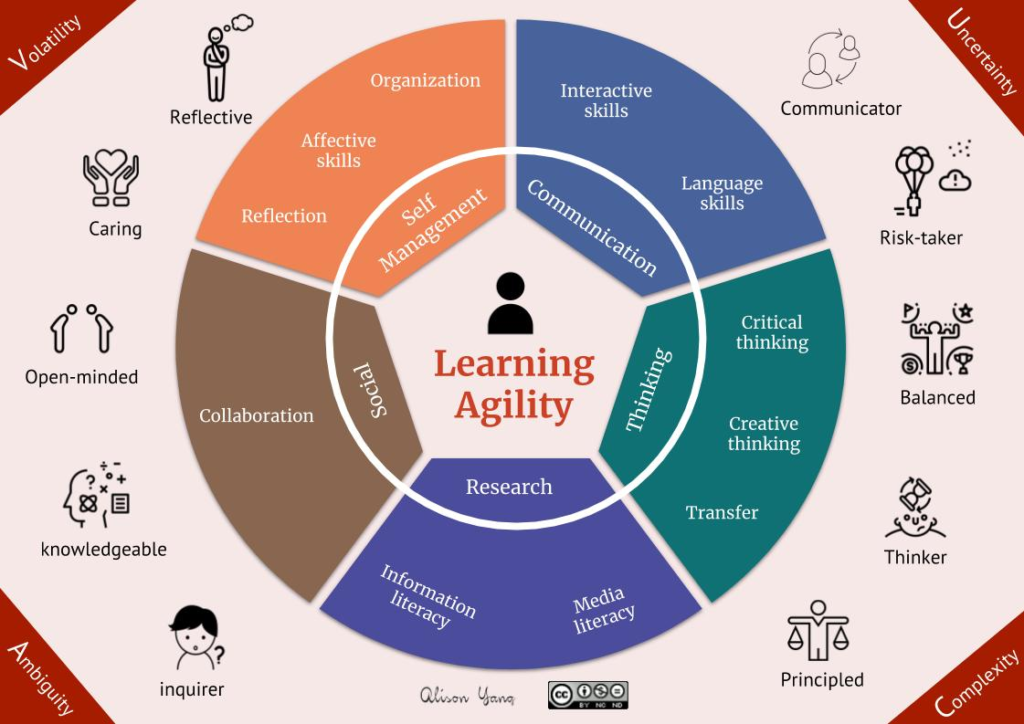
(Source: Alison Young)
Learning in the Media Center
For the past few weeks of remote learning, students have been exploring how to take good care of their books at home. CIS students see themselves as a community of readers who care for the books they enjoy. Here are some student responses to the question, How can we take good care of our books?
-
“Not ripping the pages and being caring. Books are really good. They help us to learn more things. We should not rip the pages and mark on them”. – KG1 student
-
“Handle the book with clean hands so the next reader can still enjoy the book. If you are not using the book already because you are older now, you can donate the book”. When you’re borrowing from the library, make sure you return them on time so that other students can enjoy them too. – Grade 3 student
-
“I have to make sure that they don’t break or rip the pages. I also make sure that we don’t toss them around. Don’t draw on the books or paint on them or else we can’t read them again. We should take good care of our books and read more because it makes us smarter”. – Grade 4 student
During one of our Synchronous calls with the Early Years class, we read a story about Mr. Wiggle, who loves books. The story taught us how we should take good care of our books.
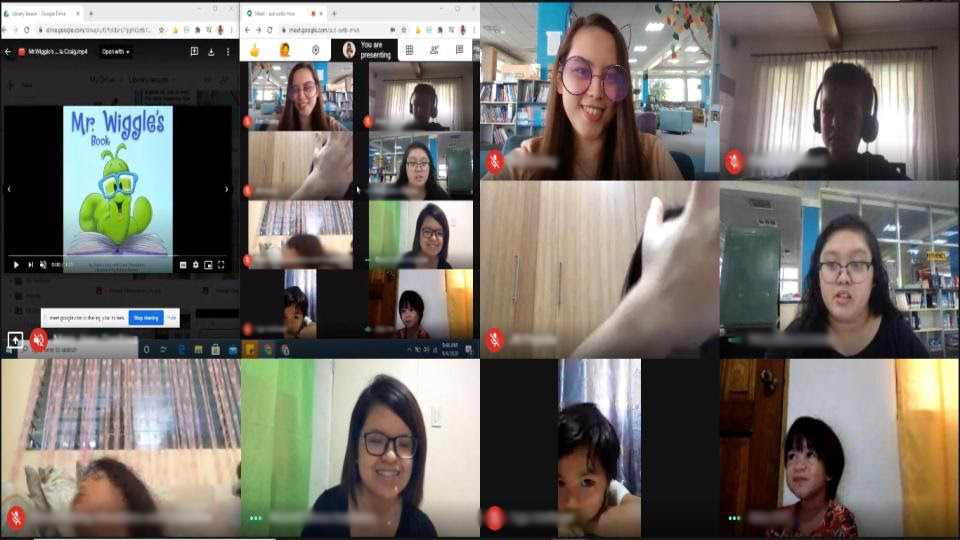
One way to make sure that our books are in good condition is to use a bookmark. During one of our synchronous calls, we made bookmarks together.
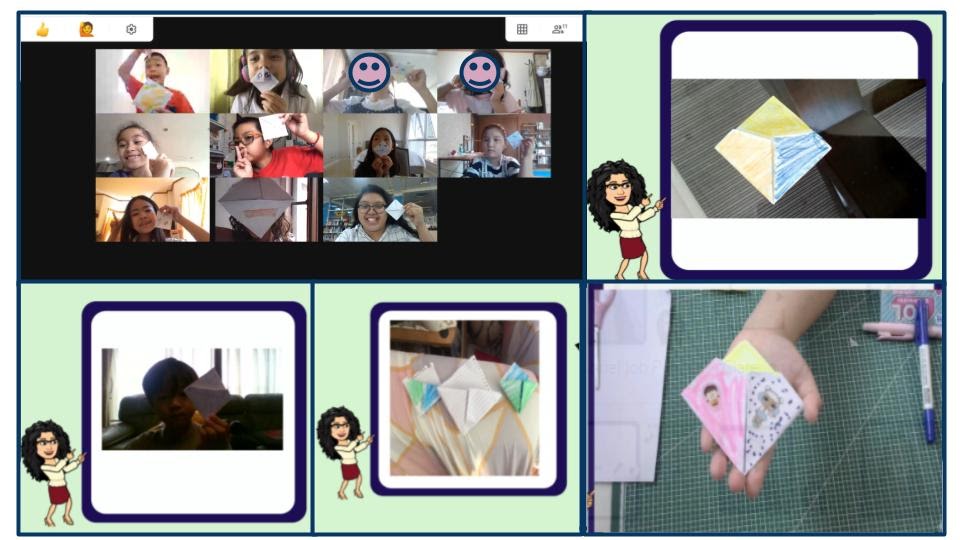
Students are also learning how to choose good-fit books using the I-PICK method and the 5 Finger Rule. As a reader, we make sure that the book that we have is a good fit so that we can understand and enjoy what we are reading.
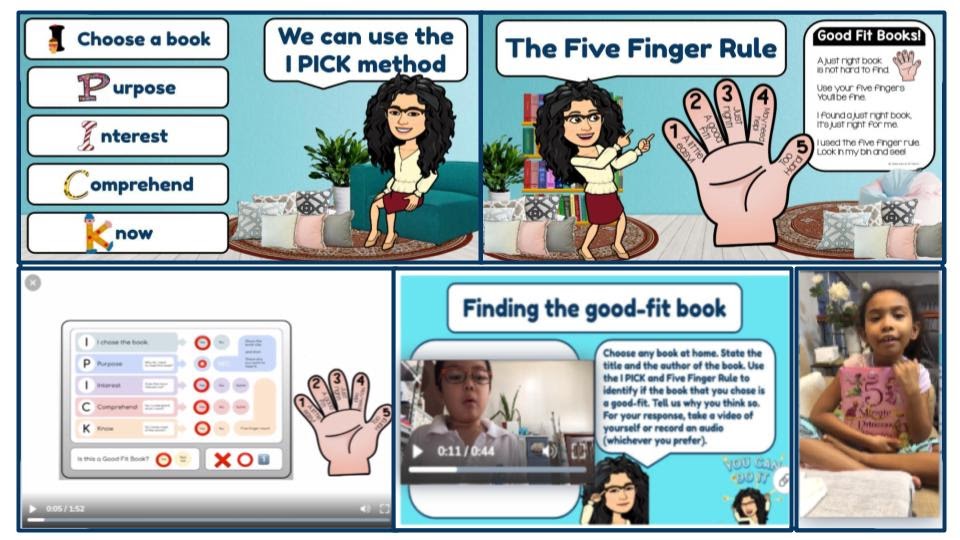
Borrowing Books from the Media Center during Remote Learning
During this continued stay at home, the Media Center is here to provide you with hours of enjoyment! Students are welcome to borrow materials using the Follett Destiny catalog. Reading is a great way to pass time, improve thinking skills, learn new information, and expand our imaginations!
Here’s the link for our library catalog https://cisph.follettdestiny.
If you have any questions about borrowing books, please feel free to reach out to any of the Library/Media Center Staff Mr. Monfre (dmonfre@cis.edu.ph), Ms. Noelle (malino@cis.edu.ph) and Ms. MJ (mcordova@cis.edu.ph).
Learning in Art
Over the past few week several teachers, EA’s and ur secretaries have been  preparing our CIS Remote Learning Art Kits. This has been a rather big job and we are thankful for the assistance Ms. Lory, Ms. Belen, Ms. Freya have given. If you have not yet been able to collect your child’s RL Art Kit, please drop by the school at some point to collect it, or we are happy to work with you if you would like to arrange delivery through a third party.
preparing our CIS Remote Learning Art Kits. This has been a rather big job and we are thankful for the assistance Ms. Lory, Ms. Belen, Ms. Freya have given. If you have not yet been able to collect your child’s RL Art Kit, please drop by the school at some point to collect it, or we are happy to work with you if you would like to arrange delivery through a third party.
Let’s look at some of the art projects CIS students have been doing during remote learning.
Early Years
The Early Years students have been exploring landscapes and Yoyo drew her chosen landscape. Yoyo has chosen colored pencils as her medium in this artwork. Yoyo describes her character as showing joy as she stands beneath the tree with the flowers.

Grade 3
The Grade 3 students watched a short film called Austin’s Butterfly. This film focused on the importance of creating several drafts before having a successful drawing. Taito has shown perseverance in his Third Butterfly Draft. After each draft, the other Grade 3s suggested helpful ways for Taito to improve this butterfly drawing.

KG/G1
Grade 1 have been exploring the concept of impressionism and brush painting. Erin Gibson has captured the style of Impressionism in this landscape Painting. Her brushstrokes show similarities to the style of Vincent Van Gogh.

Grade 4
The Grade 4 student artwork connected to their Unit of Inquiry where they have been exploring the concept of persuasion through the context of advertising. Anna proudly displays her poster, advertising Bubble Tea. Anna has worked on 2 drafts before coming up with this final piece, following the principle from Austin’s Butterfly of making several drafts and seeking feedback from others before coming up with the final piece.

Learning in Grade 3
In Grade 3, the students have been exploring what makes them unique. They did so by representing different aspects about themselves through emojis. Then, all of the students tried to see if they could recognize each of their classmates by emojis alone. Emojis have now become more than just a face on an email, they are used to regularly express feeling and convey emotions in contexts where face to face communication is not possible. Learning to navigate the tool of the emoji is quickly becoming an important social skill. As the unit has progressed we have identified and discussed what are the different unique things that connected all of us, and which of our communities they connect us to. Please see some of our work samples below.
Middle and High School News
by Mr. Dale Wood, Middle and High School Principal
Another model for examining the power of technology integration
The Greek philosopher Heraclitus has been credited with the famous quote: The only constant thing in life is change.
Our current Covid crisis has forced schools across the world to get on board with exploring and implementing the use of new technological tools; at CIS this has meant advancing and refining our use of platforms and tools we already had in place, as well as adding new technology tools and resources to help our students engage and learn. While in the past some teachers could (and sometimes did) resist innovation since they were familiar with more traditional media; however, we are now in a position where educators world-wide have had to expand their skills and use of technology in order to continue being effective practitioners within our profession. This has actually been a real “silver lining” in the midst of this crisis, as technology holds the potential for opening up doors to learning we could have only imagined in the past.
We have examined the SAMR model in the Newsflash on a couple of occasions, and this week I wanted to share the RAT model for technology integration, which is similar and perhaps a bit easier to remember. It has been said that technological advances can fall into three categories: those which replace previous methods, those which amplify previous methods, or those that engender transformation. Similar to the Redefinition level of the SAMR model, technology has the ability to transform what students are doing and create ways of learning we would not have thought possible without the use of those innovative tools.
The RAT model breaks down our use of technology into these three categories as illustrated below:
R-replacement
A-amplification
T-transformation
Just like the SAMR model, RAT gives us a framework for evaluating the impact of technology on our instructional methods, student learning processes, curriculum goals, and the assessments we are using.
Replacement
An example of replacement would be schools installing white boards back in the 20th century. While white boards may be easier for students to see and easier to clean than blackboards, there really isn’t much appreciable difference between the two types of technology. PowerPoint can provide another example of replacement. If, for example, a teacher has a three slide PowerPoint containing content that could have easily have been written on the board, he is using technology just for the sake of technology.
Amplification
With amplification, we find that the basic structure of the experience in question doesn’t change. The practices that we’re doing, though, are amplified, so things either get better or they’re done more quickly; our efficiency or productivity increases as the structure becomes streamlined. Calculators offer a pretty clear example of amplification, that is, if you know what you’re actually putting into your calculator. Google docs contain built in features that can amplify the experience, like being able to search the “version history” of your doc to revisit a paragraph you might have deleted without needing to keep a stack of revised drafts. Student work created in Google can also be enhanced through features such as auto-saving the document as well as auto-sharing and auto-linking in the cloud. However, you are still creating a piece of writing with new tools that amplify the experience.
Transformation
This is where things really get exciting, and our teachers in both ES and MHS have been experimenting with technology in ways that challenge previous structures and where a brand new paradigm can emerge, where something incredibly different is created that couldn’t have existed without the use of innovative technology. Technology has the ability to change the way we teach and change the way we think about activities we might implement to engage our students. It also has the power to change the thought processes of our students. At the transformation level, we find school or learning not as we’ve always known it, but rather we see a new paradigm emerging, where the subject matter changes, our methods for teaching change, and/or the methods for learning change. Here are examples of how we are doing this in MHS.
Example 1:
Mr. Gibson, for his Grade 9 Language and Literature class, has created an asynchronous Nearpod extension of his lesson on chapter 4 of Orwell’s Animal Farm exploring the impact of totalitarianism on education. He has created supplementary activities and questions which allow students to reinforce their understanding, as well as a short interactive video, which pauses along the way to check for and ensure student understanding.
You may access this experience by clicking on this link, entering the code RLMNO. The program also asks you to enter your name so it can record your individual responses; this feature allows Nearpod to provide both individual and class feedback, including graphs and charts to visually represent the data from the class. All of this can be generated automatically via this app.

Example 2:
Using the Flipgrid app participants make audio or video recordings and post them on the flipgrid, which is essentially a virtual message board; the messages here, however, are videos which allow students to both demonstrate their knowledge and also develop important communication skills. Other students from the class are often tasked with collaborating and offering feedback by posting their own videos in response to those on the flipgrid; these follow-up posts reinforce the students’ knowledge and allow the teacher to gauge the understanding of the class.
For example, students in Mandarin B (Grade 11 DP) may record and post their response to a newspaper article, using vocabulary specified by the teacher, and then their classmates can watch and respond to these recordings with video comments of their own (also using Mandarin). We can see here how much practice students would receive to reinforce and expand their understanding. The teacher also has the opportunity to review all of this recorded material and offer specific feedback and suggestions for further development.
Example 3:
Ms. Enrile describes her virtual classroom
The unique situation that we are in right now empowers teachers to find new ways to deliver the content during remote learning. My personal journey in daily class preparation includes designing and utilizing virtual classrooms for my science classes. A virtual classroom is a classroom with active links and embedded resources in Google slides. It is an ideal platform for sharing interactive resources with my students.
Essential to my virtual classrooms are the learning expectations, active links to varied resources and activities, synthesis discussion, formative assessments, and virtual labs when applicable. As students access the tasks in the virtual classroom, they are able to develop their understanding and skills. All resources for each lesson are conveniently located in one place and students can always revisit the virtual classroom as they review the lesson. Its use is also beneficial to the students who missed classes. Since students are able to develop their knowledge and skills asynchronously, our morning synchronous sessions are focused more on giving feedback and answering questions since the synthesis discussion has already been integrated within the virtual classroom.
The use of virtual classrooms is just one of the varied ways to keep students engaged and keep the spirit of inquiry alive even during remote learning.

In essence then, the RAT model- replacement, amplification, and transformation, is simply another framework to help us understand and evaluate how we are using technology and provides a means for us to reflect on whether or not this has been effective? While transformation is the level we aspire to, it’s important to also acknowledge that It takes both critical and creative thinking on the part of our teachers to reach that level as they create learning engagements that are truly transformative.
Creativity Activity Service (CAS)/ Service Learning
by Zoe S. and Deandra R.
With the coming of the COVID-19 pandemic, Cebu has been one of the main cities of the Philippines that has suffered the most. The Enhanced Community Quarantine has limited the ability for most Cebuanos to acquire work and money, especially for the day to day workers.
Without any work and a steady income, they were desperate to find support 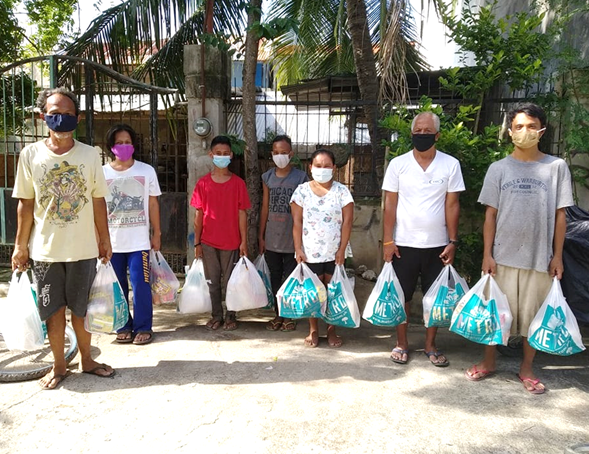 within their own communities. Most of these workers have families, so a source of money or food is essential to their survival in Cebu’s ECQ. The families that live by the riverside about a kilometer away from Villa Leyson Subdivision suffer from this situation, as they have no proper work to supply for their livelihood. Whatever finances they held had been exhausted, forcing them to find any means of work that was close to home. Since the ECQ only allowed them to move within their own barangay, finding work and money was scarce. This situation had taken a heavy toll on these poor families, as they had to work twice as hard for half the pay.
within their own communities. Most of these workers have families, so a source of money or food is essential to their survival in Cebu’s ECQ. The families that live by the riverside about a kilometer away from Villa Leyson Subdivision suffer from this situation, as they have no proper work to supply for their livelihood. Whatever finances they held had been exhausted, forcing them to find any means of work that was close to home. Since the ECQ only allowed them to move within their own barangay, finding work and money was scarce. This situation had taken a heavy toll on these poor families, as they had to work twice as hard for half the pay.
My family is fortunate enough to live comfortably in this quarantine, but when we learned of the situation of these poor families, we felt the need to help. We reached out to friends and family, my grandmother and grandfather in the USA, Ms. Pynor the Grade 5 homeroom teacher, and CIS parent Mrs. Jovi Green responded positively. They all agreed to help us support these less fortunate families, either with money or basic goods. My grandparents from the USA sent us money to partially pay for the supplies we were buying, while Ms. Pynor and Mrs. Jovi Green also contributed with donations of food and supplies. With the cooperation of all these people, we were able to support multiple families every two weeks since June.
On our first donation, we identified the families that needed it the most, one of which did not live close to the riverside but within Villa Leyson. We purchased the groceries and had the identified families collect from our home. They were grateful, even for the very basic essentials, as each family received food to sustain them for five days. In addition to food, we also donated clothes, bags, and shoes we have outgrown. We have done around eight waves of grocery donations since June, and have plans to continue in the future until these families are able to steadily support themselves.
With this, I learned that there are people who are truly suffering from Cebu’s quarantine and that my family is very fortunate enough to be able to help them. There are many more poor communities just like this all over Cebu, some of which are in worse conditions than that of the riverside. As members of the CIS community, it is within our ability to help and support these communities in any way. Be it in donations, awareness, or in any way that you can think of contributing, we can make a difference in Cebu’s current situation. – Zoe S.
Because of the pandemic that the world is facing today, many people have been vastly affected. I am planning to support the communities living by the riverside near Villa Leyson, Bacayan from selling my family’s old clothes (attached below are pictures of the area). These clothes would be sold at low prices to family and friends, which would help prevent contact with strangers (considering the Covid-19 precautionary measures) and it also allows them to thrift. All of the profit earned from the clothing will then be used to provide those families with basic necessities such as but not limited to food packs, shampoo, conditioner, and sanitary items. I have decided to do this because many people have been struggling with their jobs to support themselves and I have outgrown a lot of the items in my closet. What better way to get rid of clothes than to do it for a cause? This week, I have been successful in selling some items to my families’ households, but I think it would be a challenge to get many other people to buy a lot. I would overcome this by promoting this sale through social media platforms to spread the message. I hope to make an impact on the lives of the people living by the riverside by putting a smile on their faces and by reminding them that people care. This helps me as a learner because it allows me to be more open-minded and aware of what people are going through during these trying times. It makes me more grateful for the blessings that I have and also reminds me to bless others as well. I challenge other students to help support Cebu whether that be by donating to charities, giving provision to the less fortunate, spreading awareness about Covid-19, or even by staying at home. Let us make a difference, even while stuck in quarantine. – Deandra R.
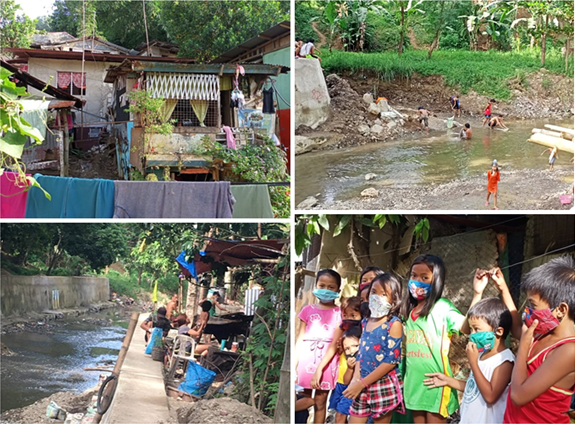
Salamat sa mga Frontliners
by Jenny B.
The COVID-19 pandemic has taken the world by storm and has led the Philippines to be in the world’s longest and strictest lockdown. During this unprecedented and difficult time, the majority of us have had the privilege of being in a safe home within the comfort of our families and preparing for a new school year in remote learning. 
On the contrary, there have been many others out there struggling to make ends meet. The pandemic has highlighted the importance of indispensable workers to our society as well as shed light on the significant imbalance in the wealth inequality of the Philippines. As we are adjusting to the new “normal”, it is crucial to understand what we could do to help our frontline workers and those who have been at work non-stop in order to provide us with our welfare.
In my case, I’ve used money that I’ve earned from working as an online english tutor for younger kids during the summer, to purchase face masks and shields to donate to the families of frontline workers. This project was meaningful to me in that I was able to give back to those who do so much for us and be able to give back a sense of gratitude and let these families know that I acknowledge and am immensely grateful for the work that the frontliners have done to help me and my family feel protected.
Going forward and embracing the changes around us, we have been taught the value of our health and safety and develop a sense of responsibility to ourselves and others by practicing health measures and protocols that are being established around us. With more cooperation and less indifference, we can fight through this pandemic and gain profound insight.
Book Donation Drive
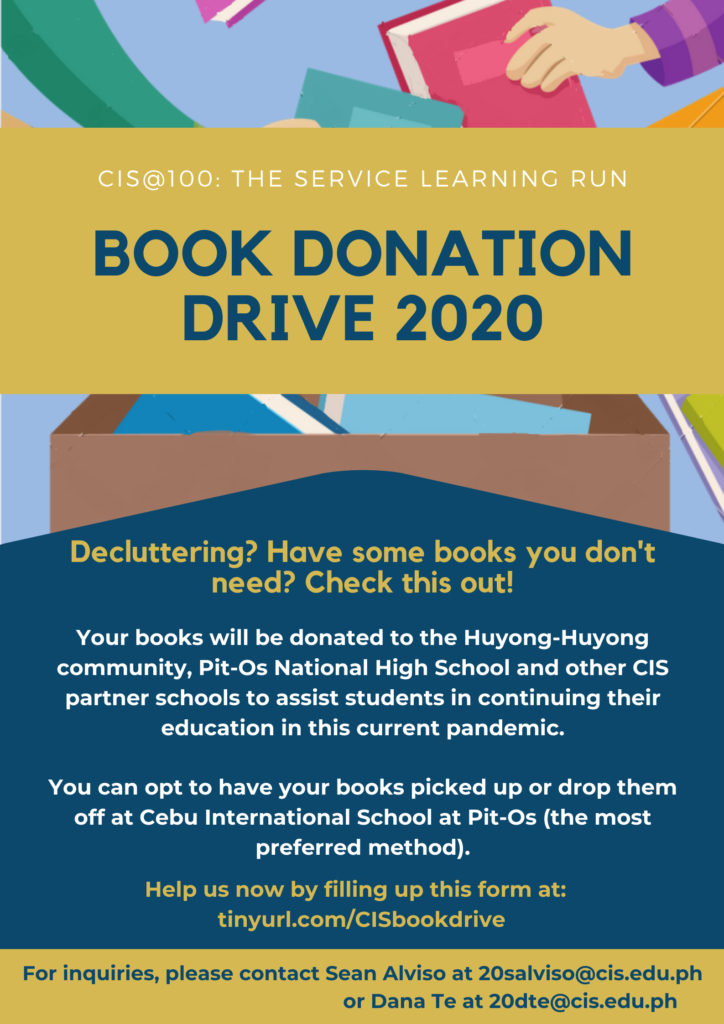
College/Careers Counselor Corner
by Ms. Jenny Basa, College/Careers Counselor
Tip for the Week:
- When writing your college essay, always start with your draft on a google doc or word document. Do not type directly into the online form where you are to submit the essay.
- Share your doc with at least 2 adults for editing. Aside from your college counselor, you can share it with a parent or a teacher for their comments.
Upcoming Virtual Visits and Fairs
DATE
September 14 – Monday
1:30 – 2:30PM
Online via zoom
September 15
Tuesday
1:00 – 1:45PM
Online via zoom
September 17
Thursday
2:30 – 3:30PM
Online via zoom
September 17 – Thursday
Available on these timezones:
04:00–07:00; 13:00–15:00 CEST (Central European Standard Time)
09:00–12:00; 18:00–20:00 ICT (Indochina Time)
7:00 – 10:00 PM PH Time (online via Zoom)
September 30
Wednesday
2:00 PM PH time
October 15
Thursday
1:00 PM
October 17-18
Saturday & Sunday
EVENT
Nagoya University of Commerce & Business (Japan)
Zoom link: https://nucba-ac-jp.zoom.us/j/94628405342
New York University Shanghai
Student Registration:
https://connect.nyu.edu/register/CebuInternationalSchool
Virtual Meeting Link: https://nyu.zoom.us/j/91953812019
New York University Abu Dhabi
Student registration: https://connect.nyu.edu/register/?id=7552d0ca-7b58-40cd-ba6e-831452425284
Zoom link: will be sent to you after you register on the link above
Council of International Schools Southeast Asia Fair
Link to Register: https://www.cois.org/for-students-and-parents/students/fairs-and-tours/southeast-asia
View the full list of attending universities (247 universities from all over the world)
Scholarships and Financial Aid
Overview of Financial Aid at Japanese national and private universities
To register, click here: https://japanuniconsortium.typeform.com/to/drhPRY
University of New Brunswick and University of Victoria (Canada) https://us02web.zoom.us/j/3183943681
Meeting ID: 318 394 3681
The password will be 946466 – Session for CIS students
EduCanda Virtual Fair
(list of institutions to follow)
SAT UPDATE:
Please note that most universities have gone test-optional. This means they do not require test scores for students to be eligible for admission.
September 26 and October 3 have been cancelled by the College Board. Test-takers registered on these dates will have received an email with instructions.
| 2020-2021 Test Dates | Test | Registration Deadline |
| September 26, 2020 | CANCELLED | |
| October 3, 2020 | CANCELLED | |
| November 7, 2020 | SAT & SAT Subject Tests | October 7, 2020 |
| December 5, 2020 | SAT & SAT Subject Tests | November 5, 2020 |
| March 13, 2021 | SAT only (no Subject tests) | February 12, 2021 |
| May 8, 2021 | SAT & SAT Subject Tests | April 8, 2021 |
| June 5, 2021 | SAT & SAT Subject Tests | May 6, 2021 |
To register for the SAT, you may click on this link. If you need assistance or have any questions, please feel free to email Ms. Jenny Basa at jbasa@cis.edu.ph.



